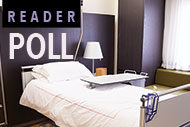Calm, peaceful and soothing. Those are a few of the words patients used to describe the waiting-room experience at Naval Medical Center San Diego as part of a study conducted by four Navy researchers.
The study, “Bridging Music and Military Mental Health,” was published in the Music & Medicine journal to show the correlation between waiting room atmosphere and patient attitude, but specifically among those with military experience.
The study’s 149 participants were split nearly in half with 76 experiencing a traditional waiting-room experience with a simple layout of chairs and daytime television programming. The other 73 patients were placed in a waiting room with soft instrumental music playing and nature scenes on the screen. Each participant completed an assessment of his or her waiting-room experience and the responses showed that those in the experimental group had statistically significantly higher pleasantness scores (two points) than their counterparts.
As part of the assessment, the researchers reserved an open comments section for patients to describe their experience in their own words. In addition to using words and phrases such as “caring environment,” “very peaceful now,” “mind let go,” “lower anxiety,” and “music puts you in a good place,” researchers say there were other trends that set the experimental group apart.
For one, patients in the music group were twice as likely to supply comments and personal reflections and the comments themselves were generally much more expressive. Patients in the music group also were five times more likely to use the adverb "very," such as “very peaceful” and “very calming,” to describe how the room made them feel. Those in the control group, however, tended to pay attention to the room's physical makeup, using words such as "small," "standard," "empty" and "stuffy."
The study’s authors say the results of this pilot study warrant a deeper look into music’s power as a medical intervention. The authors note that using music to lower stress and anxiety among the general patient population is well-researched and proven, but hasn’t been examined as closely in a military setting as to draw conclusions on its effects on mental health within this unique patient population.
“We find the connection between music interventions and the use of emotional descriptors to be intriguing, and we envision further research along these lines,” the authors write. “For instance, research investigating whether music acts as a doorway, or as a facilitator, to sensing the nuances of subjective and internal human experience may shed light on music’s subtle impact on sensation and the ability of music to relieve anxiety and stress. Moreover, we recommend that future research investigate whether there are differences between types of music and the various types of affective and physiological responses elicited by these differing forms of music. Uncovering the role of ambiance, vis-à-vis music, may prove to be a fruitful avenue for further research, too, especially in the military context, revealing more about how environments act as healing agents.”





